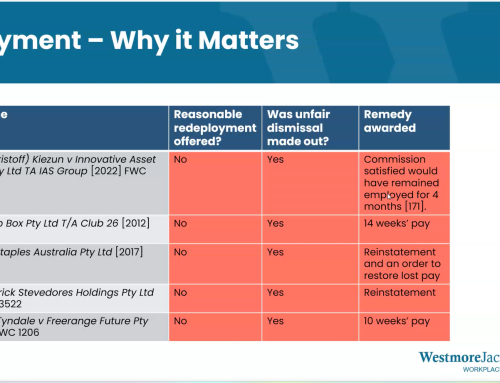
The use of independent contractors instead of employees may seem an attractive alternative for some businesses during these uncertain times. However, be warned – this area is full of traps for the unwary.
This article considers the two recent cases of Jamsek v ZG Operations Australia Pty Ltd
Both cases were concerned with the question of whether a relationship of employment or independent contracting existed between the parties. This involved the application of the “totality of the relationship” or multi-factorial test, which is how courts work out the true nature of the relationship.
We discuss each case below.
1. Jamsek v ZG Operations Australia Pty Ltd – The question is whether the person is an employee and not whether the person is conducting their own business
In Jamsek v ZG Operations Australia Pty Ltd, two delivery truck drivers (“applicants”) were found to be employees of ZG Operations Australia Pty Ltd (“company”) and not independent contractors.
The two applicants were delivery truck drivers for the same business for nearly 40 years. In 1986, the company had a round of redundancies, and the applicants were offered two options – lose their jobs, or become independent contractors for the company. They chose the latter.
As part of the deal, they were required to purchase trucks from the company at a set price. Each applicant, on advice from an independent accountant, set up partnerships which regularly invoiced the company through a “Contract Carriers Arrangement”. In 2017, the company terminated their working arrangement. The applicants then commenced proceedings for unpaid employee entitlements under the Fair Work Act 2009 (Cth) and other legislative instruments.
The Federal Court of Appeal applied the multi-factorial test, and considered the following relevant factors:
- Intention: both parties clearly had an understanding of the nature of the relationship, but the applicants had no choice but to accept the purported independent contracting arrangement. There was therefore no mutual intention.
- Partnerships: it was held that partnerships were established for the purpose of continuing employment with the company and not for the purpose of conducting any business activity.
- Broad contractual mechanism and vehicle purchase: these factors pointed towards the existence of an independent contractor relationship.
- Day-to-day control of the applicants: the company exercised a significant level of control over the applicants’ operations (such as working hours and duration of annual leave), pointing towards an employee relationship.
- The exclusivity of work and right to subcontract: the expectations (in particular around work hours from 6AM to 3PM Monday to Friday) placed on the applicants created an effective requirement to provide services exclusively to the company without a right to sub-contract.
- Ability to generate goodwill: there was no opportunity to generate goodwill for the applicants’ respective businesses given, amongst other things, their hours of work and expectation to wear company-branded items of clothing from time to time.
- Absence of written contracts: there were extensive periods where the applicants had no written contracts. The Court held that these circumstances weighed slightly in favour of an employment relationship. This is because an independent contractor might be more anxious to ensure the maintenance of a legally binding written contract.
In these circumstances, the truck drivers were found to be employees. This was despite carefully drafted contractual terms defining them as independent contractors. As a result, the company was ordered to pay workplace entitlements, superannuation and long service leave for the last 40 years to both “employees”.
This case is unique in a sense that not every relationship lasts that long. However, it shows the courts will approach the matter of deciding the true nature of the relationship by assessing the reality of the relationship, rather than the terms of the written contract alone.
In contrast to this case, we now consider CFMMEU v Personnel Contracting Pty Ltd, where the written terms of the contract played a crucial role in deciding that there was no employment relationship.
2. CFMMEU v Personnel Contracting Pty Ltd – The “totality of the relationship” test does not always work in “trilateral” relations
In CFMMEU v Personnel Contracting Pty Ltd, a 22-year old backpacker (“applicant”) with little construction experience was required to obtain an ABN to sign-up with a labour-hire company, Personnel Contracting Pty Ltd (“Personnel”). Through this labour-hire arrangement, he worked for a few months as a labourer on construction sites in Perth under the supervision and control of a building company, Hanssen Pty. Ltd. (“Hanssen”). The question on trial and appeal was whether the applicant was an employee of Personnel or an independent contractor.
In applying the multi-factorial approach, the trial Judge considered the following factors were significant:
- Day-to-day control: Personnel did not control the applicant’s day-to-day operations.
- Own business: the applicant did not conduct his own business, which suggested he may be an employee.
- Contract terms: the contract was carefully drafted and pointed towards an independent contractual relationship.
The trial Judge also considered the following factors to be of little significance:
- Hourly pay: the fact that the applicant was paid by the hour was somewhat indicative of an employment relationship.
- Provision of equipment: Hanssen provided some tools and equipment to the applicant, which indicated an employment relationship. However, the applicant was not provided with any company-branded uniform, was excluded from staff functions and specifically required in the contract not to represent himself as an employee.
As a result of this exercise, the trial Judge placed more emphasis on the written terms of the contract as the “tie-break” factor and held that the applicant was not an employee.
On appeal, although recognising the difficulty in applying the multi-factorial approach to “trilateral” relations, also commonly referred to as “Odco-system contracts”, the Court was reluctant to find the reasoning of the trial Judge erroneous. The main reason being the appeal was materially identical to the facts of an older case, Personnel Contracting v CFMEU [2004] 84 WAIG 1275, in which the person was also found to be a contractor.
In these circumstances, the Full Court of the Federal Court held that they had no jurisdiction to distinguish the current matter before them from the older case.
The Justices conceded that if unconstrained by the authority of the same level court, they would have found that this was an employment relationship.
Allsop CJ remarked that this case and others like it raise the issue of “residual weight to be given to the [written] contract, especially when the other factors affecting the characterisation process are seen to be evenly weighted” (at [34]).
In his closing remarks, Lee J commented that (at [187]):
“…“the days of the Odco system may be numbered.” Given that contractual obfuscation is just as likely to be prevalent in the context of tripartite relationships as in the case of bilateral relationships, the focus of Heenan J in Personnel Contracting v CFMEU (at 44 [52]) on the “substance of the relationship and not its form” has real resonance.”
As a result of this decision, Personnel was able to engage some workers as independent contractors.
However, for businesses considering a similar model of engagement, one may ask themselves whether the risk is worth taking given their Honours’ comments above.
Conclusion
This area is murky and not for the faint hearted. Businesses should be cautious when engaging independent contractors and obtain legal advice from an Employment Lawyer before doing so.
Adam Colquhoun, Principal
This article is general information only. It is not legal advice. If you need legal advice, please contact us.
Title quote: Per Perram J, Jamsek v ZG Operations Australia Pty Ltd [2020] FCAFC 119 at [8].





